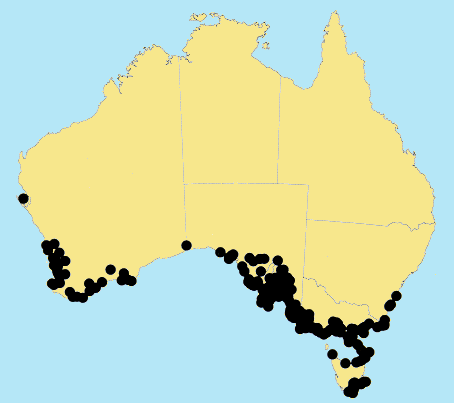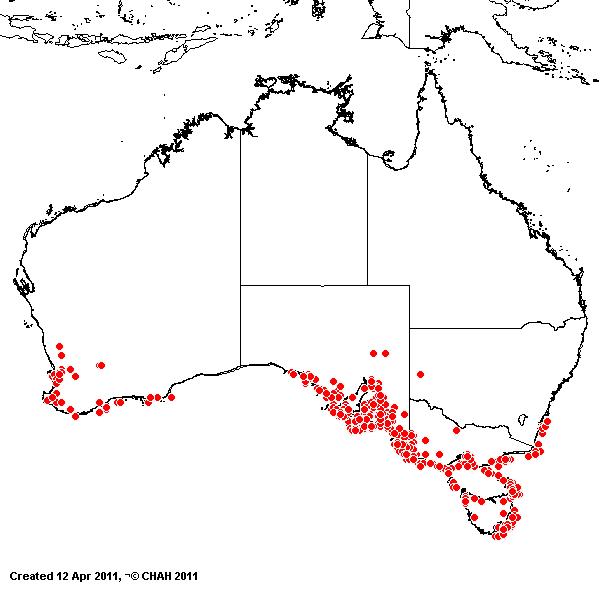Austrostipa flavescens (Labill.)
S.W.L.Jacobs & J.Everett. Telopea 6: 585 (1996).
Classification. (GPWG 2001) : Subfamily Pooideae. Tribe Stipeae.
Basionym and/or
Replacement Name: Stipa
flavescens.
Type of Basionym or
Protologue Information: HT: Labilliere s.n., Australia (FI-W; IT: G,
K).
Recent synonyms:
Stipa aphanoneura, S. compacta, S. elatior, S. hirsuta, S. tenuiglumis.
Key references
(books and floras): [1810]. R.Brown, Prodromus (175 as Stipa),
[1878] G.Bentham, Flora Australiensis 7 (566 as Stipa flavescens),
[1952] C.A.Gardner, Flora of Western Australia 1 Gramineae (180
as S. hirsuta), [2002] D.Sharp & B.K.Simon, AusGrass, Grasses of
Australia, [2002] J.Wheeler, N.Marchant & M.Lewington, Flora of the
South West (403), [2006] J.Jessop, G.R.M.Dashorst, F.M.James, Grasses of
South Australia (93), [2008] S.W.L.Jacobs, R.D.B.Walley &
D.J.B.Wheeler, Grasses of New South Wales (154), [2009] A.Wilson (ed.). Flora
of Australia, Vol 44A. Poaceae 2 (29).
Illustrations:
[2006] J.Jessop, G.R.M.Dashorst, F.M.James, Grasses of South Australia (94, Fig. 56), [2008] S.W.L.Jacobs,
R.D.B.Whalley & D.J.B.Wheeler, Grasses of New South Wales, 4th edn
(154), [2009]. A.Wilson (ed.), Flora of Australia 44A: Poaceae 2
(31, Fig 4).
Habit.
Perennial. Rhizomes present, short. Culms erect or geniculately ascending,
stature robust to moderate, 40–120 cm tall, 3–4 -noded. Mid-culm nodes
pubescent. Leaf-sheaths glabrous on surface. Ligule a fringed membrane, a
ciliolate membrane, 0.3–0.6 mm long, truncate. Leaf-blades flat or involute or
convolute, 9–54 cm long, 2–7 mm wide. Leaf-blade surface scaberulous, glabrous.
Inflorescence.
Inflorescence compound, a panicle or a panicle. Panicle linear, 10–40 cm long,
2 cm wide.
Spikelets.
Spikelets pedicelled. Fertile spikelets 1-flowered, comprising 1 fertile
floret(s), without rachilla extension, lanceolate, terete, 9.8–15 mm long.
Glumes. Glumes
similar, thinner than fertile lemma. Lower glume lanceolate, hyaline, without
keels, 3 -nerved. Lower glume surface indumented. Upper glume lanceolate,
8.5–12(–14) mm long, hyaline, without keels, 5 -nerved. Upper glume surface
indumented.
Florets.
Fertile lemma 7.5–12 mm long, without keel. Lemma surface indumented. Lemma
apex entire or dentate or lobed, awned, 1 -awned. Median (principal) awn 40–70
mm long overall, with a twisted column. Column 8–30 mm long. Palea without
keels. Lodicules present. Anthers 3. Grain 3.5–4 mm long.
Continental
Distribution: Australasia.
Australian
Distribution: Western Australia, South Australia, New South Wales,
Victoria, Tasmania.
Western Australia:
Eucla, Drummond, Menzies, Eyre. South Australia: Eyre Peninsula,
Northern Lofty, Murray, Yorke Peninsula, Southern Lofty, Kangaroo Island,
South-eastern. New South Wales: South Coast. Victoria: East
Gippsland, Gippsland Plain, Otway Plain, Otway Range, Wilsons Promontory,
Volcanic Plain, Wannon. Tasmania: King Island, Furneaux Group, North
West, North East, West Coast, East Coast.
Notes. Headlands and sandy
soils close to the coast of all southern States, including New South Wales.




